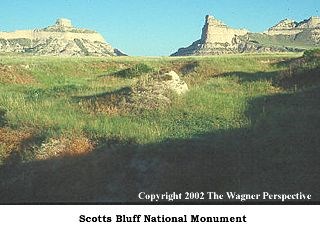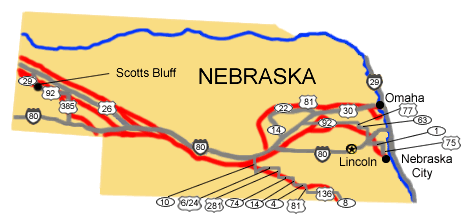
The Wagner Perspective Scotts Bluff National Monument/Mitchell PassScotts Bluff was the last famous landmark along the "Great Platte River Road" in Nebraska. In 1845, General Philip St. George Cooke marveled at the strange formation that rose before him. "Looming afar over river and plain was 'Scott's Bluff,' a Nebraska Gibralter; surmounted by a colossal fortress and a royal castle, it jutted on the water. . . . This morning marched three miles still nearer to that mysterious mountain . . . without being disenchanted of its colossal ruins and phantom occupants." This immense sandstone and clay formation blocked wagon travel along the south bank of the North Platte River, forcing early travelers to swing south and go through Robidoux Pass, a natural gateway in the great bluffs. In 1850, a shorter route was opened through Mitchell Pass, which stayed closer to the river and eliminated the eight-mile swing south. A short section of deep and eroded trail ruts in Mitchell Pass has been developed as a walking and interpretive trail. A paved road allows visitors to drive to the top of the bluffs. From this vantage point, a magnificent panoramic view is available well into Wyoming. On a clear day, visitors can see Laramie Peak, almost 60 miles to the west. The National Park Service also maintains a museum, which contains many of William Henry Jackson's paintings of the 19th century American West. How do I visit?Scotts Bluff National Monument 
NPS Image |
Last updated: April 23, 2025
